I have long loved needle lace in most of its forms.
I’ve not explored it in serious depth, but I have dabbled with it, read about it, and in general, I’m always attracted by needle lace, both ancient and modern. There are certain types of needle lace that appeal to me more than others, and there are various practical uses of needle lace techniques in embroidery (or in finishing) that I think are worth knowing for any embroiderer.
Lately, I’ve been considering some further explorations of needle lace, and to that end, I’ve been pulling together my own resources and discovering a few new ones.
Today, I’d like to show you a needle lace book that I came across lately, that I like and that I think has some excellent merits when it comes to instructional content.
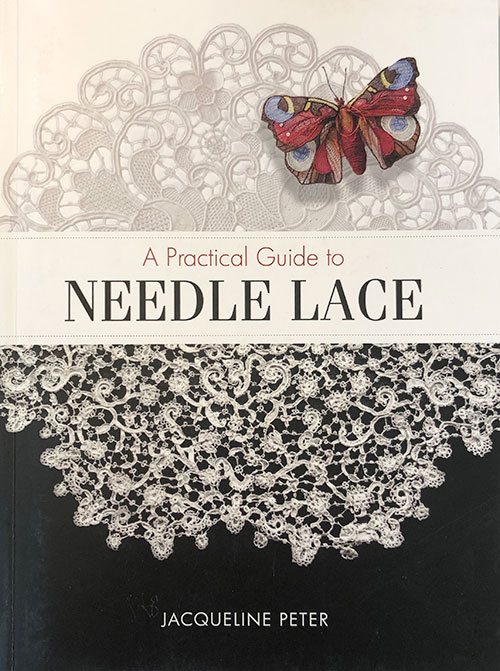
A Practical Guide to Needle Lace by Jacqueline Peter was originally published in France as Guide pratique: la dentelle à l’aiguille, and it is an excellent overview of needle lace.
Needle lace is lace that is made using needle, threads, and a fairly limited variety of what we know as embroidery stitches. There are various types of needle lace, but the gist is that they are formed from stitches using a needle and thread – just as you would embroidery. They are not made with a crochet hook, knitting needles, bobbins, or a tatting shuttle (although there is such thing as needle tatting) and so forth.
If you are intrigued by needle lace techniques and are interested in a general overview of the subject of needle lace, as well as instruction to get you started exploring needle lace, A Practical Guide to Needle Lace is a worthwhile book to have for reference, instruction, and practice.
The book has its pros and cons, which I’ll discuss as we take a look at it.
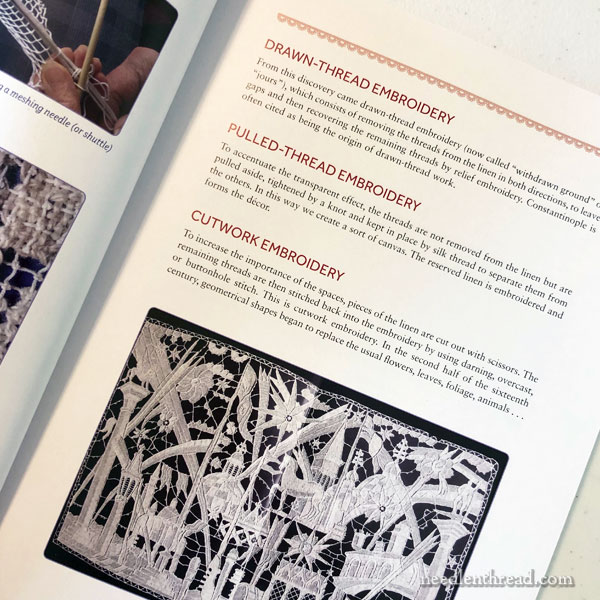
I appreciate that the book begins with some history and development of needle lace. I think this type of information helps to put needlework techniques into context, so that we can see the traditions that we’re building on as we explore them and bring them to life in new ways.
Whenever I look at any kind of art, I want to see where it has come from and where it is going, so these historical introductions are important to me. This one is good and readable, and it divides the history of needle lace techniques into a kind of flowing development from one technique to the other, putting them in context of time and place.
It also delivers clear photos of different types of needle lace and explains what type they are and how they differ from similar types.
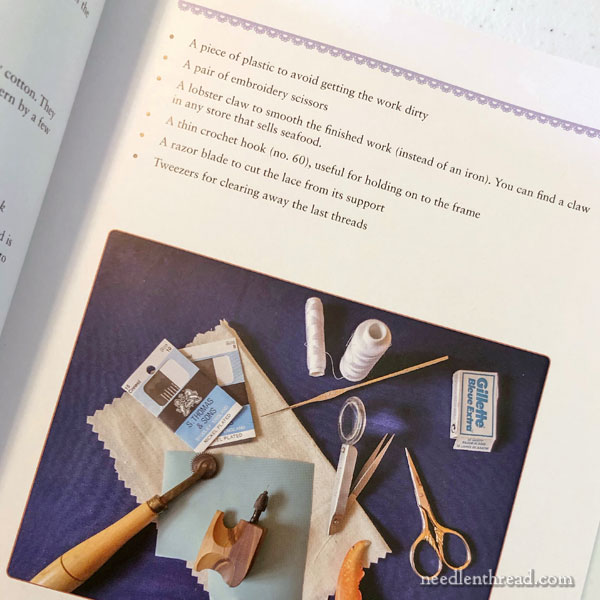
Then we move into the materials required for needle lace – which are not complicated at all!
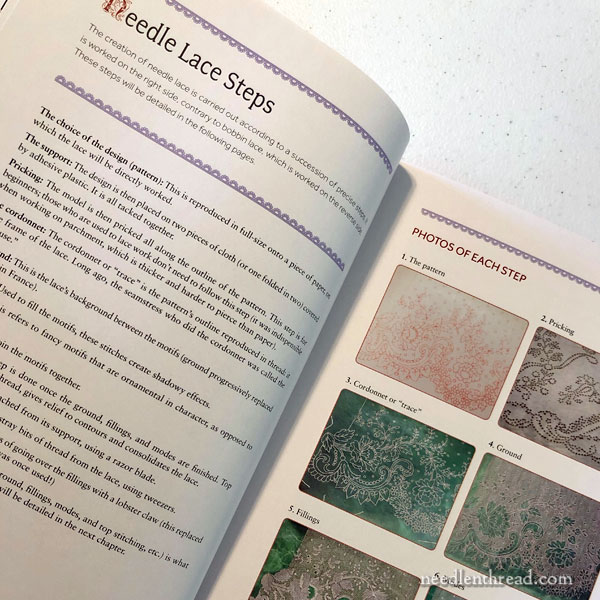
From here, the book moves into a general overview of how needle lace is created and the basic techniques involved.
At this point, it isn’t so much about specific instruction as it is about giving the reader an idea of what is involved in creating needle lace.
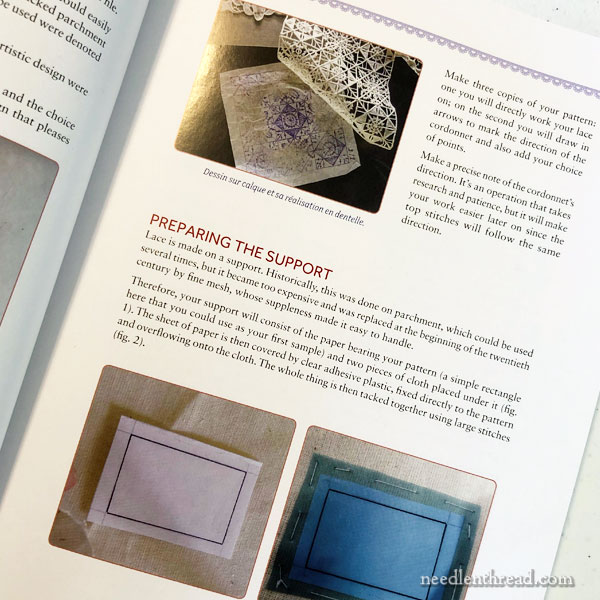
It’s in this section that you learn about setting up a needle lace project, the basic principles to follow in working a design, and so forth.
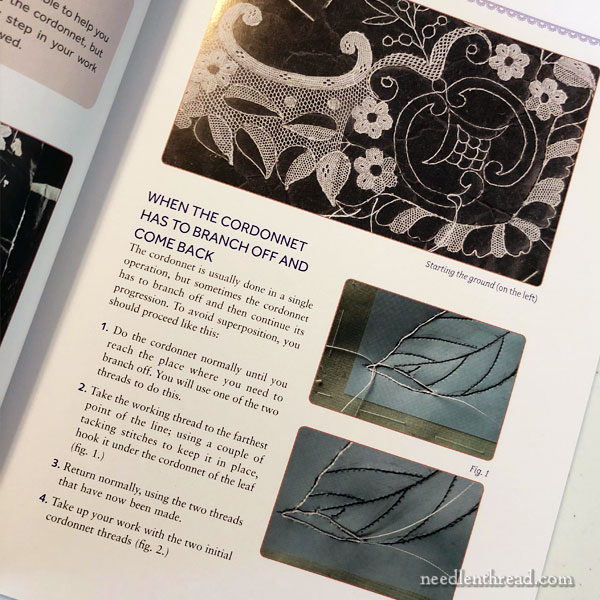
We learn about the order of work, what parts to tackle first, how the work should flow from one part to another, and all the general information that would apply to any specific project, small or large.
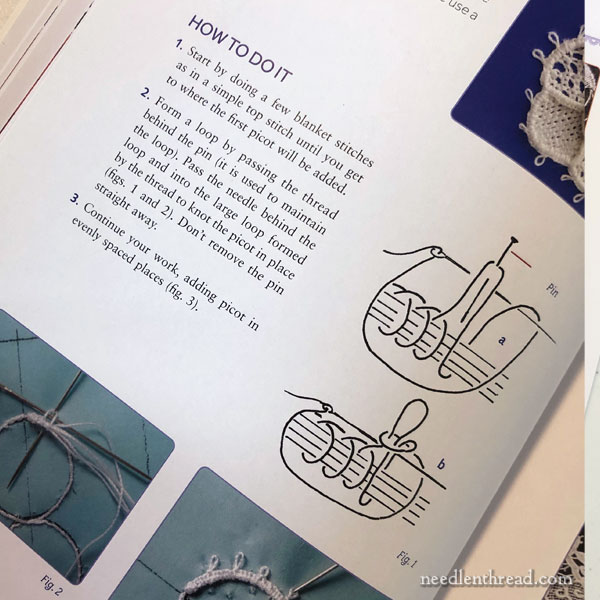
Then, the book moves into more specific instruction, with explanations and diagrams that demonstrate the principal “points” (stitches) of needle lace.
As you work your way into the book, this is perhaps where an obvious negative aspect of the book comes into play. I’m guessing that the translation was probably done by a professional service involving people who are not familiar with needlework.
The translation from French to English is a bit sticky, and the translation of technical words relating to textiles, embroidery, needle lace and so forth are either missed altogether or awkwardly translated. It really is a shame that some publishing companies don’t seek professionals in the field to help them create better and more accurate translations.
Nevertheless, there’s nothing in here that you can’t understand, even if you have no knowledge of French. The translation could just be smoother and bit more consistent.
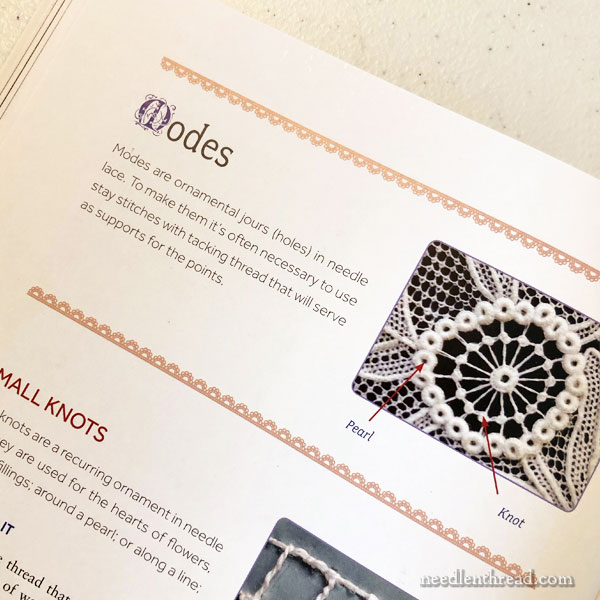
The instruction, which covers the stitches used in needle lace (and many variations), fillings, decorative elements, and grounds, is excellent. The hand-drawn diagrams, the photo tutorials, and the written explanations are all clear and easy to understand.
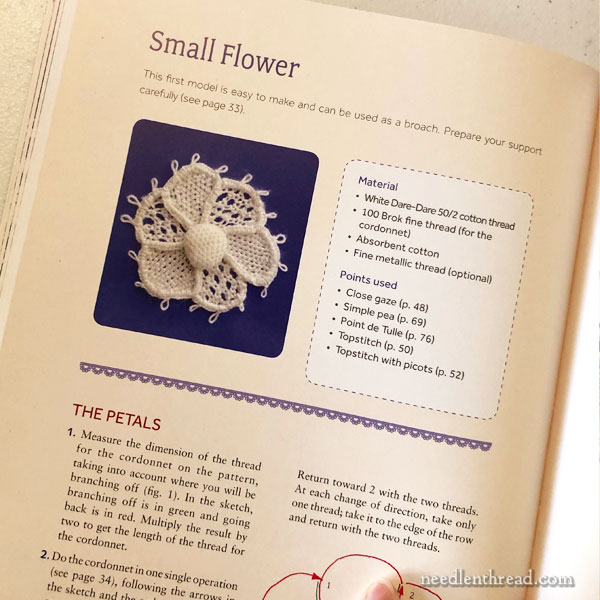
At the end of the book, there are six small and manageable practice projects that build on the skills covered in the instructional part of the book. The projects start basic and they progress to slightly more complex.
Following this, there is an author’s gallery of modern needle lace work.
In a Nutshell
New needle lace instructional and project books are fairly rare these days. While there are some good ones out there (old and new), there aren’t a lot of them. So I was really happy to come across such a good overview of techniques that instructs well and gives the opportunity for guided practice projects.
I think the book is worth having if you have any interest in needle lace. It would also be a handy book for folks who have an interest in stumpwork (which sometimes involves needle lace fillings).
The only real negative to the book, in my mind, has been mentioned – the translation is not as good as it could be. There are also captions that were not translated at all (so the editing lacks a bit, too). Weighed against the content, though, these difficulties are minor.
Where to Find It
A Practical Guide to Needle Lace is available through the following book sources:
If you’re in the US, you can pick it up through Amazon. You’ll find it on my Amazon Recommendations page here, under the “Browse my Amazon Recommendations” list.
Worldwide, with free shipping, you can find it through Book Depository here.
This article contains affiliate links to book sources, which means that Needle ‘n Thread receives a small commission for purchases made through those links with no extra cost to you. Every little bit helps, so thank you for using my affiliate links!







Hello Mary,
I saw that there is a “needle lace technique” . For someone starting, which book would you recommend?
thank you
Mary, when you have a moment can you show needle lace as finishing? Thanks as always. My library is beginning to exceed my shelves!
I’m thinking in terms of needle lace edges and the like – buttonholed scallops on edges… with picots.
Thanks Mary! I’m working on a new Lavender and Honey Needlebook, and that gives me a great idea!
I just have to comment on that first photo from inside the book:
https://needlenthread.wpengine.com/wp-content/uploads/2020/09/practical-guide-to-needle-lace-02.jpg
(second from the top in this post.) HOLY MOLY! That is just insanely impressive.
Thanks for this, Mary – I have always been interested in needle lace, not least because you don’t need any specialized equipment.
Needle lace fascinates me, too! There’s a Turkish lady I follow on Facebook who does a kind of needle lace called *oya*, mostly seen as edgings. I bought a headscarf trimmed in this kind of lace from some Bulgarian women at a folk festival, and my Armenian friends call it “Armenian lace”. An elderly aunt gave me a handkerchief with an ornately crocheted lace edging; she had cut off one corner and filled it in with a butterfly.
Do you know of any English-language books on this kind of work? Does this book mention oya lace?
It’s a shame about the poor quality of the translation. Publishers should take much more care to get that right, as well as the copy editing.
Still, it looks like a good book, especially for those of us who know a little French.
I want to try needle lace but i find it so intimidating.I have hazel blomkamp’s book c but it does not have step by step pictures or diagrams. I need a bit more hand holding,more step by step pics.
Hi Mary.
I read this article with great interest as it reminded me of a lacemaking technique that used to be practiced in my part of the UK, the English Lake District.
The technique is called “Ruskin Lace” and and was devised by John Ruskin the famous 19th century painter after he came to live near Coniston in the 1800s. He saw the poverty of the local people and this calabrative effort was invented to try and improve their living standards.
Ruskin Lace is a combination of drawn thread, cutwork, and needlepoint lace and I seem to remember Ruskin got the idea from seeing, (I think) Italian women making lace.
The small industry died out in the mid 1900s with only one or two people carrying on making the lace. I learned the rudiments of it in the ’80s when a lady called Elizabeth Pricket taught some night school classes. Ms Pricket also wrote a very good book on the subject called “Ruskin Lace and Linen Work”.
The book starts with history of Ruskin Lace, an explanation of the techniques etc. with lots of very good diagrams and photographs, over 60 needlepoint lace patterns and about a dozen projects; and its all in english.
There was an exhibition of the lace held at the Coniston Museum a year or two ago. Some were historical pieces and a few more modern ones. The pieces were beautiful and intricate they stood up very well in comparison to work I’ve seen in the V & A.
I would also like to say how much I enjoy your work. Reading this column 3 times a week and seeing you develop projects has started me embroidering again after a more than a thirty years break.
Your ‘how to’ videos are such a help and your downloadable patterns invaluable.
As you say, postage to the UK is very expensive so without the patterns I’d be struggling. Thank you very much.
Long may you continue.
Pat
This does look really intriguing! But I’d rather spell my way through the original French instead of struggling with an extra layer of translation. Mary, do you have an affiliate recommendation for the original French version of the book?
I found a random-ish listing for it here:
https://www.kantcentrum.eu/en/webshop/boeken/la-dentelle-a-laiguille-guide-pratique-jacqueline-peter
but appreciate having your recommended affiliate choices to order from as I’ve found them very reliable.
No, I don’t have an affiliate link for the French version, but thanks for asking! 🙂
Oh, Jacqueline’s book translated in English, nice for her! You can find her blog (in French) here.
She is a very good lacemaker, both bobbin and needle.
Dear Mary
A Practical Guide to Needle Lace by Jacqueline Peter looks like a very good instructional book even if the translation is not very good and would suit those who are interested in the craft. The small manageable projects look good for the beginner. I am interested in needle lace, it’s a craft that would be great to learn, hopefully one day.Thank you for reviewing A Practical Guide to Needle Lace and for the photos and your thoughts on the book and for sharing it with us. Thank you.
Regards Anita Simmance
The only thing you didn’t include was a copy of the table of contents showing the techniques/types covered! 🙂 🙂 I have a copy of The Open Canvas by Ambruter. Is this a good companion volume for that book?
I don’t have a copy of The Open Canvas, so I don’t know. But perhaps someone else will read your question and be able to answer it.
I inherited many lace tablecloths , linen towels and doilies that I know were used in the early 1910’s and 1920’s in Philadelphia PA.
How can I find out their value? What sources are legitimate in estimating resale values?
I think your best bet would be to contact an antique dealer who works with textiles, or to contact a museum that has a good textile department.